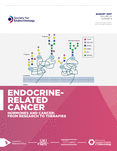WOMEN IN CANCER THEMATIC REVIEW: Ovarian cancer–peritoneal cell interactions promote extracellular matrix processing
- 1Discipline of Obstetrics and Gynaecology, Adelaide Medical School, Robinson Research Institute, University of Adelaide, Adelaide, South Australia, Australia
- 2Lung Research Laboratory, Hanson Institute, Department of Thoracic Medicine, Royal Adelaide Hospital, Adelaide, South Australia, Australia
- 3Department of Gynaecological Oncology, Royal Adelaide Hospital, Adelaide, South Australia, Australia
- Correspondence should be addressed to C Ricciardelli; Email: carmela.ricciardelli{at}adelaide.edu.au
Abstract
Ovarian cancer has a distinct tendency for metastasising via shedding of cancerous cells into the peritoneal cavity and implanting onto the peritoneum that lines the pelvic organs. Once ovarian cancer cells adhere to the peritoneal cells, they migrate through the peritoneal layer and invade the local organs. Alterations in the extracellular environment are critical for tumour initiation, progression and intra-peritoneal dissemination. To increase our understanding of the molecular mechanisms involved in ovarian cancer metastasis and to identify novel therapeutic targets, we recently studied the interaction of ovarian cancer and peritoneal cells using a proteomic approach. We identified several extracellular matrix (ECM) proteins including, fibronectin, TGFBI, periostin, annexin A2 and PAI-1 that were processed as a result of the ovarian cancer–peritoneal cell interaction. This review focuses on the functional role of these proteins in ovarian cancer metastasis. Our findings together with published literature support the notion that ECM processing via the plasminogen–plasmin pathway promotes the colonisation and attachment of ovarian cancer cells to the peritoneum and actively contributes to the early steps of ovarian cancer metastasis.
- Received 18 August 2016
- Accepted 30 August 2016
- Made available online as an Accepted Preprint 30 August 2016
- © 2016 Society for Endocrinology












